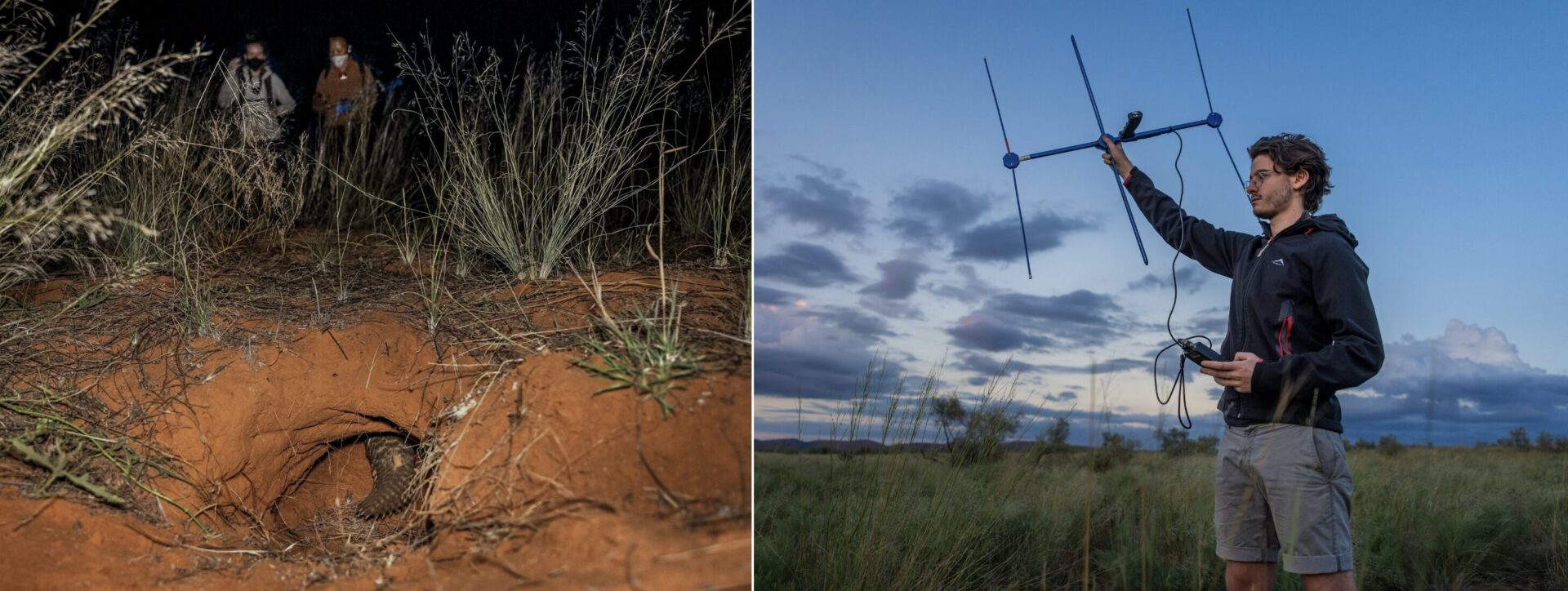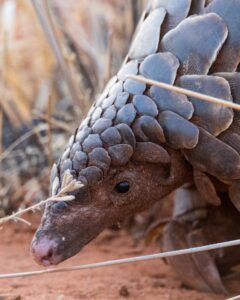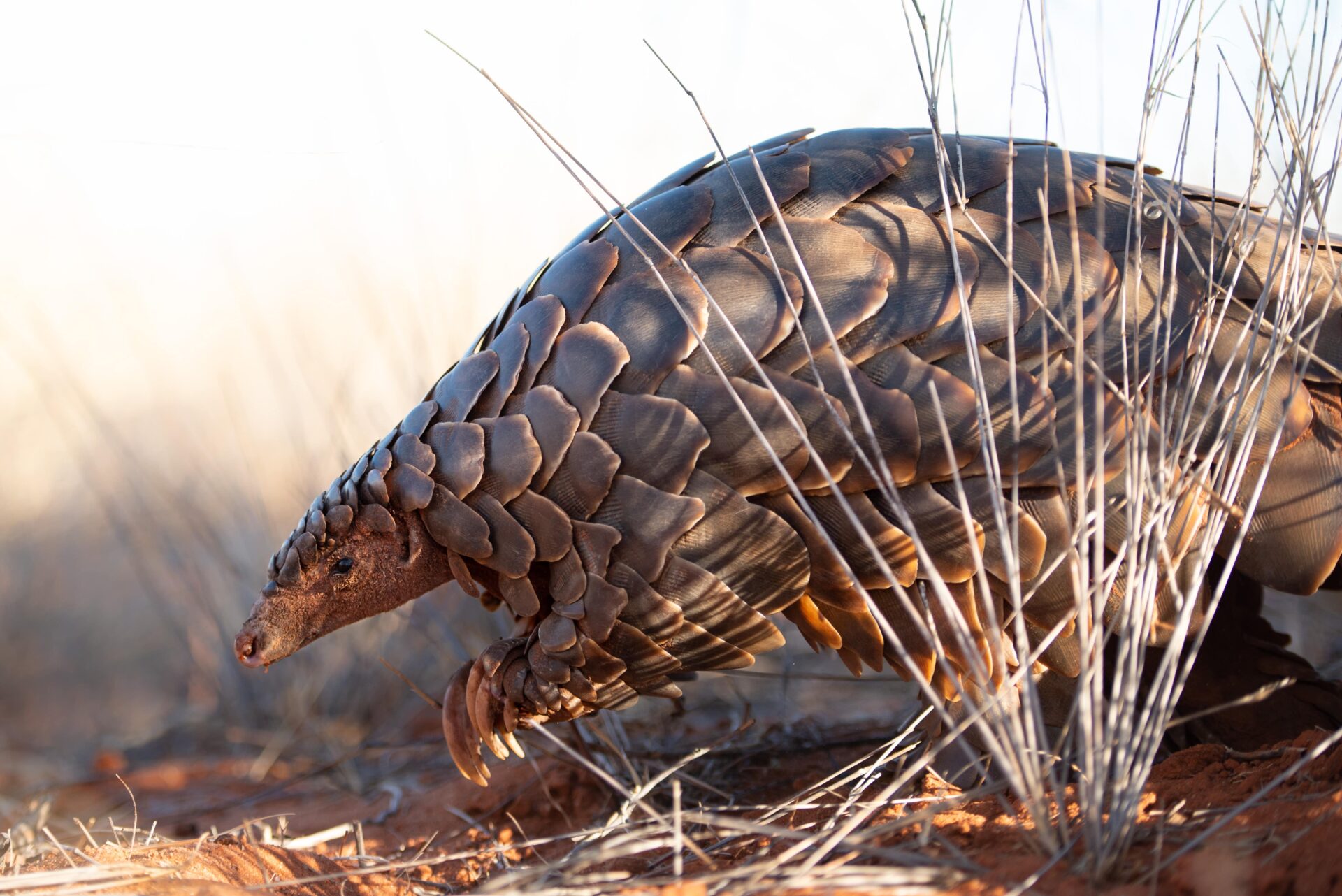Researching the mystical Temminck’s pangolin
No one knows exactly how many pangolins roam South Africa’s wilds. And that’s part of the problem. As the world’s most trafficked mammal, the pangolin is both a conservation priority and an enigma. Benjamin Melamdowitz, a Wits master’s student, spent a year at Tswalu working to change that, one elusive animal at a time.
Finding pangolins in South Africa’s largest private reserve
Armed with a telemetry set, a headlamp, and a deep curiosity, Ben managed to tag six Temminck’s pangolins, the only pangolin species that occurs in Southern Africa. “This shows how elusive they are – and how challenging research on them can be,” he explains.
Everybody dreams of seeing a pangolin in the wild or, at the very least, learning more about this notoriously shy creature. Having access to scientists, like Ben, who can provide firsthand experience of a close encounter with one of these animals, adds another layer to the Tswalu safari experience.
But why pangolins?
“I’m not hugely species-specific,” he says, “but pangolins just fascinated me. There’s so little information about them; it felt like learning about something mythical. The more I read, the more I wanted to know.”

Pangolin poaching statistics
That curiosity quickly met a sobering reality: no one really knows how many pangolins are left. “Trying to estimate population size or density is incredibly difficult,” Ben explains. “Their ranges overlap, and they’re nocturnal and secretive.” One oft-cited number suggests that as many as 200,000 pangolins are poached every year across Africa. “If that number’s anywhere close to accurate,” he says, “then it’s almost certainly not sustainable.”
Studying pangolin habits
Ben’s research focused on habitat use: what pangolins eat, where they forage, and what kinds of vegetation attract the insects they eat. “I was hoping to link feeding behaviour to vegetation quality,” he explains. “Are pangolins found in healthier landscapes or are they able to occur across a wide variety of habitat types? Do certain trees or grasses provide better access to food?”
“What I learnt is that they don’t seem too picky,” he says. “That’s good news from a conservation standpoint; it suggests they might adapt to different habitats.” However, when it comes to prey, pangolins are specialists. “They’re targeting very specific ants and termites – primarily Anoplolepis and Crematogaster ants, and Trinervitermes termites. So while the plants aren’t necessarily the limiting factor, the availability of these prey items might be.”
In the cooler months, Ben noticed something curious. “Even when new green grass is abundant, they often forage in old, dry grass tufts. I guessed that the ant colonies have established there over time, perhaps using root systems or shelter.” The pangolins seem to favour grey camel thorn (Vachellia haematoxylon), but again, it’s unclear whether that’s preference or simple abundance.
Late nights with Africa’s most elusive creature
Tracking a pangolin is a feat of patience. Ben had to rely heavily on Tswalu’s guides and trackers, who alerted him to signs of pangolin movement, usually faint tracks crossing sandy roads. “If they found fresh signs, we’d try to track the animal to its burrow and wait, often for hours, for it to emerge.”
Most pangolin activity happens at night, especially in the summer months. “My day would start when everyone else was winding down,” he says. “Once an animal has been located using a VHF transmitter, you have to sit quietly near the burrow, waiting.” Once the pangolin emerges, it has to be followed at a distance – sometimes for up to three hours – while recording every interaction with plants and potential prey.
When he was not tracking pangolins, Ben was busy with insect transects, collecting ants and termites in pitfall traps to gauge prey abundance, or doing vegetation surveys across the reserve. “This work involves long hours and a lot of solitude,” he admits. “But I also had the privilege of spending a year in this incredible reserve, studying an animal few people ever get to see in the wild.”
![]()
Saving pangolins – from academia to applied conservation

While pangolins have become something of a conservation celebrity, scientific research remains limited. Overall, pangolins are still understudied. “A lot of work is focused on rehabilitation,” Ben notes, referring to efforts to care for animals confiscated from the illegal wildlife trade.
That’s not surprising. Pangolin research is notoriously tricky. “You can plan a project and never actually find an animal,” he says. “They’re that elusive.”
Despite the challenges, Ben remains committed to the cause, though perhaps not through the traditional academic route. He doesn’t plan to pursue a PhD, at least not yet. “I’m more interested in applied conservation, in building resilient systems that work for wildlife and people,” he says. “That might involve economic and social dimensions, not just ecological ones.” Still, pangolins will remain close to his heart. “There’s something mystical about them,” he says.
About the author: Yves Vanderhaeghen writes for Jive Media Africa, science communication partner of Oppenheimer Generations Research and Conservation.
Image and video credits: Wendy Panaino, Gerry van der Walt, Marcus Westberg, Mike Sutherland
